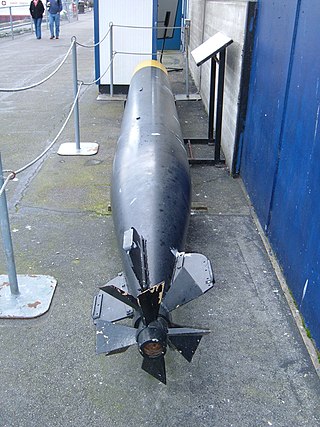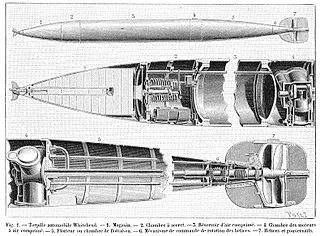Related Research Articles

A modern torpedo is an underwater ranged weapon launched above or below the water surface, self-propelled towards a target, and with an explosive warhead designed to detonate either on contact with or in proximity to the target. Historically, such a device was called an automotive, automobile, locomotive, or fish torpedo; colloquially a fish. The term torpedo originally applied to a variety of devices, most of which would today be called mines. From about 1900, torpedo has been used strictly to designate a self-propelled underwater explosive device.

The Howell Automobile Torpedo was the first self-propelled torpedo produced in quantity by the United States Navy, which referred to it as the Howell Mark I torpedo. It was conceived by Lieutenant Commander John A. Howell, United States Navy, in 1870, using a 60 kg (130 lb) flywheel spun at a very high speed to store energy and drive propellers.

The Mark 14 torpedo was the United States Navy's standard submarine-launched anti-ship torpedo of World War II. This weapon was plagued with many problems which crippled its performance early in the war. It was supplemented by the Mark 18 electric torpedo in the last two years of the war. From December 1941 to November 1943 the Mark 14 and the destroyer-launched Mark 15 torpedo had numerous technical problems that took almost two years to fix. After the fixes, the Mark 14 played a major role in the devastating blow U.S. Navy submarines dealt to the Japanese naval and merchant marine forces during the Pacific War.

The Whitehead torpedo was the first self-propelled or "locomotive" torpedo ever developed. It was perfected in 1866 by British engineer Robert Whitehead from a rough design conceived by Giovanni Luppis of the Austro-Hungarian Navy in Fiume. It was driven by a three-cylinder compressed-air engine invented, designed, and made by Peter Brotherhood. Many naval services procured the Whitehead torpedo during the 1870s, including the US Navy. This early torpedo proved itself in combat during the Russo-Turkish War when, on 16 January 1878, the Ottoman ship Intibah was sunk by Russian torpedo boats carrying Whiteheads, though this story has been disputed in one book.
Gregory Caldwell Davison was a naval officer, inventor and a Vice President of the Electric Boat Company in Groton, Connecticut.
Frank McDowell Leavitt (1856–1928) was an American engineer and inventor. Leavitt devised one of the earliest machines for manufacturing tin cans and later invented the Bliss-Leavitt torpedo, the chief torpedo used by United States Navy in World War I. Leavitt was part of an emerging cadre of American engineers whose design feats were putting United States manufacturing might on the map at the dawn of the twentieth century.

The Bliss–Leavitt Mark 8 torpedo was the United States Navy's first 21-inch (530 mm) by 21-foot (6.4 m) torpedo. Although introduced prior to World War I, most of its combat use was by PT boats in World War II. The torpedo was originally designed in 1911 by Frank McDowell Leavitt of the E. W. Bliss Company and entered full mass production in 1913 at the Naval Torpedo Station in Newport, Rhode Island. It was deployed on destroyers and battleships during World War I and cruisers built in the 1920s. All US battleships and most cruisers had their torpedo tubes removed by 1941. The Mark 8 remained in service through World War II on older destroyers, primarily the Wickes and Clemson classes. It also equipped PT boats early in World War II, but was replaced by the Mark 13 torpedo on most of these in mid-1943.

The Bliss-Leavitt torpedo was a torpedo designed by Frank McDowell Leavitt and manufactured by the E. W. Bliss Company of Brooklyn, New York. It was put into service by the United States Navy in 1904 and variants of the design would remain in its inventory until the end of World War II.
The Schwartzkopff torpedo was a torpedo manufactured in the late 19th century by the German firm Eisengießerei und Maschinen-Fabrik von L. Schwartzkopff, later known as Berliner Maschinenbau, based on the Whitehead design. Unlike the Whitehead torpedo, which was manufactured out of steel, the Schwartzkopff was made out of bronze, enhancing corrosion resistance.
The Whitehead Mark 1 torpedo was the first Whitehead torpedo adopted by the United States Navy for use in an anti-surface ship role after the E. W. Bliss Company of Brooklyn, New York secured manufacturing rights in 1892. The US Navy made an initial acquisition of 100 Mark 1s, which, by the time they entered American service, were faster, had longer range and carried a larger warhead than Robert Whitehead's earlier models.
The Whitehead Mark 2 torpedo was a Whitehead torpedo adopted by the United States Navy for use in an anti-surface ship role after the E. W. Bliss Company of Brooklyn, New York secured manufacturing rights in 1892. It was identical to the Whitehead Mark 1 torpedo, except for some mechanical details.

The Whitehead Mark 3 torpedo was a Whitehead torpedo adopted by the United States Navy for use in an anti-surface ship role after the E. W. Bliss Company of Brooklyn, New York secured manufacturing rights in 1892.
The Whitehead Mark 5 torpedo was a Whitehead torpedo adopted by the United States Navy for use in an anti-surface ship role in 1910. The Mark 5 was the first torpedo to be manufactured by a foreign company, the Whitehead facility in the United Kingdom, and in 1908, by the Naval Torpedo Station in Newport, Rhode Island. It was also the first torpedo to allow the firing ship to vary the torpedo's speed and range.
The Bliss-Leavitt Mark 1 torpedo was a Bliss-Leavitt torpedo adopted by the United States Navy for use in an anti-surface ship role after the E. W. Bliss Company of Brooklyn, New York, which had been building Whitehead torpedoes for the US Navy, began designing and manufacturing their own torpedoes in 1904.
The Bliss-Leavitt Mark 2 torpedo was a Bliss-Leavitt torpedo adopted by the United States Navy for use in an anti-surface ship role after the E. W. Bliss Company of Brooklyn, New York, which had been building Whitehead torpedoes for the US Navy, began designing and manufacturing their own torpedoes in 1904. It was the first American-built torpedo to feature counter-rotating turbines, each driving a propeller. This design eliminated the unbalanced torque that contributed to the tendency of its predecessor to roll.
The Bliss-Leavitt Mark 3 torpedo was a Bliss-Leavitt torpedo adopted by the United States Navy in 1906 for use in an anti-surface ship role.
The Bliss-Leavitt Mark 6 torpedo was a Bliss-Leavitt torpedo developed and produced by the E. W. Bliss Company in 1911. It employed a main engine that was a horizontal turbine rather than the vertical turbine used on all other Bliss-Leavitt torpedoes. The Mark 6's depth and gyro controls were also combined into one integrated unit. About 100 units were manufactured by E.W. Bliss. It was used on cruisers, destroyers and submarines of the E, F, G and H classes. The Mark 6 and all other torpedoes designed before Bliss-Leavitt Mark 7 torpedo, were considered obsolete and withdrawn from service in 1922.

The Bliss-Leavitt Mark 7 torpedo was a Bliss-Leavitt torpedo developed and produced by the E. W. Bliss Company and the Naval Torpedo Station in Newport, Rhode Island in 1911.

The Short Mark 7 torpedo was a variant of the Bliss-Leavitt Mark 7 torpedo developed by the Washington Navy Yard in order to fit certain submarine torpedo tubes in 1917. The Short Mark 7, also designated Torpedo Type D, had an air flask that was shortened and a reduced warhead weight. The fuel and water tanks were relocated to obtain more air flask capacity; the fuel tank was mounted in the aft air flask bulkhead, while the water tanks were mounted in the after-body. The overall weight of the warshot torpedo was 590 pounds lighter and 58 inches shorter than the Mark 7. The air, fuel and water capacities were approximately one-third of the capacities found on the full-size Mark 7. This torpedo was never produced in quantity.
The Bliss-Leavitt Mark 9 torpedo was a Bliss-Leavitt torpedo developed and produced by the E. W. Bliss Company and the Naval Torpedo Station in Newport, Rhode Island in 1915. The Mark 9 was originally intended to be used on battleships. Before the Mark 9 could be issued, however, use of torpedoes on battleships was discontinued and Mark 9 torpedoes were placed in storage. These torpedoes were modified for deployment on R-class and S-class submarines, and used in early World War II to supplement the initial supply of Mark 14 torpedoes. Torpedo production for the U.S. Navy was terminated by the E.W. Bliss Company about 1920 after completion of the Mark 9 project.